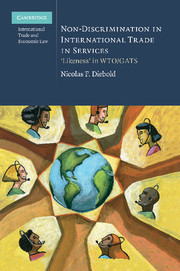Book contents
- Frontmatter
- Contents
- Foreword
- Acknowledgements
- Abbreviations
- List of Cases
- List of Legal Texts
- List of Documents
- Introduction
- PART I Foundations
- PART II Framing the conceptual breadth of ‘likeness’ in GATS
- PART III GATS specific ‘likeness’ issues
- 9 The scope of GATS rules on non-discrimination
- 10 ‘Likeness’ across ‘services’ and ‘suppliers’
- 11 ‘Likeness’ across ‘methods’ and ‘modes’ of supply
- 12 Concluding summary: merged test and crossover ‘likeness’
- PART IV Methodology for the ‘likeness’ analysis in GATS
- Bibliography
- Index
10 - ‘Likeness’ across ‘services’ and ‘suppliers’
Published online by Cambridge University Press: 10 January 2011
- Frontmatter
- Contents
- Foreword
- Acknowledgements
- Abbreviations
- List of Cases
- List of Legal Texts
- List of Documents
- Introduction
- PART I Foundations
- PART II Framing the conceptual breadth of ‘likeness’ in GATS
- PART III GATS specific ‘likeness’ issues
- 9 The scope of GATS rules on non-discrimination
- 10 ‘Likeness’ across ‘services’ and ‘suppliers’
- 11 ‘Likeness’ across ‘methods’ and ‘modes’ of supply
- 12 Concluding summary: merged test and crossover ‘likeness’
- PART IV Methodology for the ‘likeness’ analysis in GATS
- Bibliography
- Index
Summary
Scholars addressing the issue of ‘suppliers’ in GATS rules on non-discrimination argued that the reference to services and suppliers in GATS MFN treatment does not have any practical significance because ‘any treatment of services is also, in effect, a treatment of the suppliers thereof and vice versa’. This denial of practical significance is overly broad for two reasons. First, as demonstrated above, the reference to the supplier is an important precondition in order to ensure equal treatment of suppliers who trade under modes 3 and 4. Second, the argument omits to differentiate between the two elements of the non-discrimination principle, namely ‘less favourable treatment’ and ‘likeness’. In fact, each element is affected differently by the inclusion of the supplier in the non-discrimination obligation. The observation that ‘any measure applying to the service applies indirectly to the supplier and vice versa’ is only true for the element of ‘less favourable treatment’. It essentially means that a complainant only needs to demonstrate ‘less favourable treatment’ of either its service or its supplier, as the treatment of one indirectly affects the treatment of the other.
However, prior to the scrutiny of ‘less favourable treatment’, it is necessary to determine whether ‘likeness’ exists between the two comparators. In other words, even if a measure treats the supplier and, consequently, the service less favourably, the non-discrimination obligation is only breached if the element of ‘likeness’ is met.
- Type
- Chapter
- Information
- Non-Discrimination in International Trade in Services‘Likeness' in WTO/GATS, pp. 186 - 219Publisher: Cambridge University PressPrint publication year: 2010

